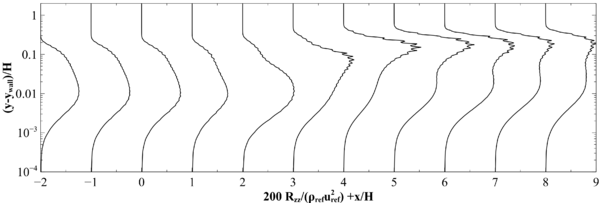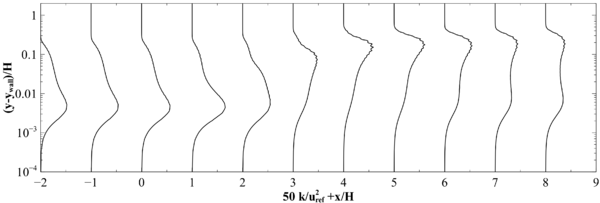DNS 1-5 Statistical Data
Statistical data
In this section the relevant statistical data for the flow on the smooth bump computed with MIGALE is given. The reported data is the one mentioned in Table 1 of the list of desirable quantities (PDF).
The data is available as:
- In .pvtu (ASCII) format as volumetric data.
- In CSV (text) format as vertical profiles at various x-positions.
Volume data
Volumetric data on the statistics computed for the whole computational domain are provided here. For more information regarding the stored quantities and the storage format, please refer to the storage format guidelines.
The available files are:
- mean pressure and velocity components (64.7 GB).
- Reynolds stress components (72.6 GB).
- velocity triple correlation (106.9 GB).
- pressute-velocity correlation (48.3 GB).
- Taylor microscale and Kolmogorov length and time scales (46.8 GB).
Profile data
Profile data have been extracted at different streamwise locations () and made dimensionless with respect to reference quantities (, , , see UFR 3-36: Table 2). The data stored in each file are:
- streamwise location
- vertical location
- wall distance
- average pressure
- average velocity components
- Reynolds stress components
- turbulent kinetic energy
Profiles at selected streamwise locations are reported in Fig. 10.

|

|

|

|

|

|

|

|

|
| Figure 10: HiFi-TURB-DLR rounded step, profiles at selected stremwise locations |
|---|
Contour data
Contour data of averaged velocity components and Reynolds stresses is also provided in Fig. 11. Notice that Reynolds stresses and are one order of magnitude smaller than the other Reynolds stresses, thus denoting the uncorrelation of streamwise and normalwise velocity fluctuations with respect to spanwise velocity fluctuations.

|

|

|

|

|

|

|

|
| Figure 11: HiFi-TURB-DLR rounded step, contours of averaged velocity components and Reynolds stresses |
|---|
Additional data
The following averaged quantities are provided along the solid wall:
- the pressure coefficient
- the skin friction coefficient
The pressure coefficient is defined as , where is the pressure at wall at the checkpoint , while the skin friction coefficient is defined as . and are the velocity and density at the reference conditions (see UFR 3-36: Table 2), respectively. Both coefficients have been obtained by averaging along the span direction the time averaged solution.
| wall_dns.csv |
 |

|
| Figure 11: HiFi-TURB-DLR rounded step, pressure and skin friction coefficients on the solid wall | |
|---|---|
Contributed by: Francesco Bassi, Alessandro Colombo, Francesco Carlo Massa — Università degli studi di Bergamo (UniBG)
© copyright ERCOFTAC 2024


















